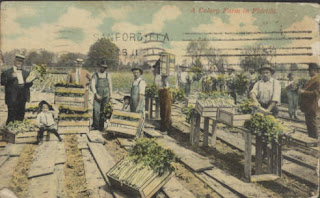 |
| This 1899 image from the Library of Congress shows young women in a sewing class at the Agricultural and Mechanical College in Greensboro, N.C. The scene was similar at Florida schools. Women predominated in the needle trades in that era. |
In my first post about the 1890 U.S. Census, I reviewed the primary fields of employment nationally and for Floridians. This second post addresses some of the other jobs held by Florida pioneers that year.
Because I come from a long line of women skilled in the needle arts, I'm especially interested in that line of work. My ancestors were plying the trade in Central and Southern Europe in 1890, and in New York City sweatshops and garment factories in the early 1900s. My grandmothers and great-grandmothers were tailors, seamstresses, and milliners. Not sure what the difference is between tailor and seamstress, but the former was a label held by my maternal great-grandmother in Sicily. From what I understand, it was a title of honor. She was specifically known as a tailor and not a tailoress. She was said to create fitted garments for clients without needing a pattern.
No matter where the trade was practiced, its elements and processes were similar. Women bent over needles in Florida the same time my ancestors did elsewhere, in much the same way. The heroine of my second novel, Stitching a Life in Persimmon Hollow, is a seamstress who works by hand and on a treadle sewing machine in late 1880s Florida. In the novel, she apprentices with the town dressmaker. Most towns had a dressmaker, sometimes known as a mantua maker in the earlier years of the 19th century. Many tradespeople took in apprentices.
No one reported being a milliner or dressmaker apprentice in 1890 Florida, although two men were tailor apprentices. No one in the state was employed as a corset-maker, glove-maker, umbrella- and parasol-maker, or shirt-, collar- and cuff-maker. Instead, people in the Florida needle trades were doing the following:
- Hat- and cap-makers: 8 men, 4 women
- Embroiderers and lace-makers: 3 women, 0 men
- Milliners: 109 women, 0 men
- Dressmakers: Either 604 or 654 women (chart numbers are hard to read), 0 men
- Seamstresses: 924 women, 0 men
- Tailors and tailoresses: 130 men, 80 women
- Actors: 2 men, 2 women
- Authors, and literary and scientific persons: 18 men, 7 women
- Journalists: 108 men, 7 women
- Musicians and teachers of music: 138 women, 56 men
- Theatrical managers, showmen: 30 men, 1 woman
- Bartenders: 188 men, 0 women
- Auctioneers: 14 men, 0 women
- Hucksters and peddlers: 145 men, 5 women
- Bakers: 178 men, 10 women
- Bookbinders: 15 men, 4 women
- Confectioners: 48 men, 8 women
- Photographers: 90 men, 4 women
Knowing a little something about how people passed their days brings their lives into sharper focus for me. When I pick up a needle and thread, select fabric for a jacket or quilt, brush up on my crochet skills, or stitch a seam on my sewing machine, I feel a sense of kinship with past practitioners. And that's a good feeling to have.

